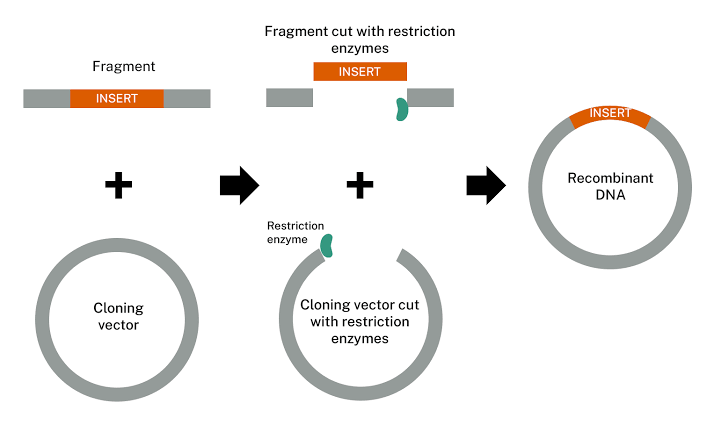
Cloning is a molecular biology technique that involves creating copies of specific DNA sequences. The fundamental principles of cloning include the following steps:
- Vector Preparation: A vector, typically a plasmid, is prepared to receive the DNA insert. This involves digesting the vector with restriction enzymes to create compatible ends for ligation.
- Insertion of DNA: The DNA sequence of interest (insert) is also digested with the same or compatible restriction enzymes to generate cohesive ends. The vector and insert are then joined together using an enzyme called ligase in a process known as ligation.
- Transformation: The recombinant DNA molecule (vector + insert) is introduced into a host organism, usually bacteria like E. coli, through a process called transformation. This allows the host cells to replicate the recombinant DNA and express any genes it carries.
- Selection and Screening: After transformation, only those cells that have successfully taken up the recombinant DNA are selected for further analysis. This often involves using antibiotic resistance markers present on the vector.
- Analysis of Clones: Finally, clones containing the desired insert are identified and characterized through various screening methods to confirm successful cloning.
Bacterial Transformation
Bacterial transformation is a crucial step in molecular cloning where foreign DNA is introduced into bacterial cells, allowing them to acquire new genetic traits. The process can be summarized as follows:
- Preparation of Competent Cells: Bacteria, such as E. coli, must be made competent to take up foreign DNA. This can be achieved chemically (e.g., treating with calcium chloride) or physically (e.g., electroporation).
- Introduction of Plasmid DNA: Once competent cells are prepared, they are mixed with plasmid DNA containing the gene of interest and subjected to heat shock or electrical pulses to facilitate uptake.
- Recovery Phase: After transformation, bacteria are allowed to recover in a nutrient-rich medium without antibiotics for a short period to express any antibiotic resistance genes encoded by the plasmid.
- Plating on Selective Media: Transformed cells are then plated on agar containing antibiotics that select for those bacteria that have successfully taken up the plasmid.
- Colony Formation: Only those bacteria that contain the plasmid will grow into colonies on selective media due to their antibiotic resistance.
Screening for Recombinants
Screening for recombinants is essential in identifying which transformed bacterial colonies contain the desired genetic material after transformation has occurred. Common methods include:
- Antibiotic-Based Screening: Transformants are selected based on their ability to grow on media containing specific antibiotics due to antibiotic resistance genes present in the vector.
- Blue-White Screening: This method distinguishes between recombinant and non-recombinant colonies based on color differences when using vectors containing the lacZ gene, which encodes β-galactosidase that hydrolyzes X-Gal into blue pigment; white colonies indicate successful insertion disrupting lacZ.
- Colony PCR: A rapid method where individual colonies are screened by PCR amplification using primers specific for the insert or flanking regions of the vector; successful amplification indicates presence of the insert.
- Restriction Digest Analysis: Isolated plasmids from selected colonies can be digested with restriction enzymes followed by gel electrophoresis; different band patterns indicate whether an insert is present and its orientation within the vector.
- Sequencing Confirmation: For definitive verification, sequencing may be performed on positive clones to confirm that they contain the correct insert sequence without mutations or errors.
The combination of these methods ensures efficient identification and selection of recombinant clones suitable for further research or application in biotechnology.







